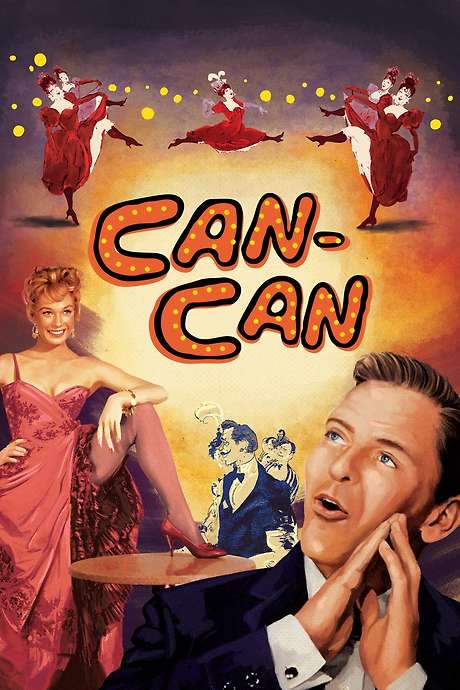
Can-Can
Year: 1960
Runtime: 142 mins
Language: English
Director: Walter Lang
A flamboyant Parisian nightclub owner famous for daring can‑can shows draws the ire of a self‑righteous judge, who schemes to secretly photograph her performance. His plan backfires when he falls hopelessly in love with her, much to the annoyance of her devoted lawyer boyfriend. The resulting romantic entanglement complicates the lively Paris nightlife.
Warning: spoilers below!
Haven’t seen Can-Can yet? This summary contains major spoilers. Bookmark the page, watch the movie, and come back for the full breakdown. If you're ready, scroll on and relive the story!
Can-Can (1960) – Full Plot Summary & Ending Explained
Read the complete plot breakdown of Can-Can (1960), including all key story events, major twists, and the ending explained in detail. Discover what really happened—and what it all means.
In the lively heart of Montmartre, Paris, the Bal du Paradis glows every night with a daring can-can that many deem lewd, even as it dazzles a crowd hungry for spectacle. The cabaret’s star, dancer and proprietor Simone Pistache choreographs the high-kicking numbers with a fearless mix of grace and mischief, turning the stage into a haven where music, movement, and flirtation fuse into something electric. The club’s orbit broadens when her lover and ally, the clever and protective François Durnais, a lawyer by trade, brings along his powerful friend, the chief magistrate Paul Barrière. Their presence promises protection, but it also pulls the dance hall into a maze of law and desire that neither Simone nor the men fully anticipate.
One busy evening, a police raid shatters the routine. Claudine—one of the dancers on Simone’s stage—along with her colleagues, are hauled before the court. The charges hang over the club like a storm cloud, and the air between the raided performers and the judges crackles with unresolved tension. Paul Barrière wishes the women’s arrests dismissed, hoping to shield the Bal du Paradis from scandal. Yet his younger associate, Philippe Forrestier, believes the law must be upheld to preserve public decency. With a mix of cunning and caution, Philippe slips into the cabaret in disguise, gathering evidence and, almost by accident, meeting Simone in a way that stirs a surprising and forbidden attraction. She senses his true identity, but his charm is overshadowed by the reality of his job, and Claudine soon warns her that the man is a judge with the power to decide her fate.
Despite this growing pull, Philippe presses ahead, and Simone is arrested once more when a raid is staged. In a bid to bend the outcome, François resorts to blackmail, threatening to expose a compromising photograph that could topple Philippe’s case. Yet Philippe counters with a surprising resolve: he has already decided to step away from the case, and then he makes a bold proposal—romance and commitment—asking Simone to marry him. Simone, torn between her independence and the possibility of a future with Philippe, asks François to stay out of the arrangement, but he refuses the notion of ever tying himself to marriage. As plans swirl, Paul worries that Philippe’s career may crumble if he takes the leap, but the younger man forges ahead, determined to chart his own path.
When the couple’s engagement seems to invite a new era of legitimacy, Paul devises a plan to test the truth in a different way. He stages a lavish riverboat party for the would-be bride and groom, hoping to trap them in a moment of weakness. Under the influence of wine and performance, Simone is coaxed into a bawdy routine before a refined, upper-class audience. Humiliation follows as she staggers away from the boat, vowing to leave Philippe behind and questioning whether love can survive among judgment and social scrutiny.
Yet the flames of ambition and loyalty burn bright. Simone accepts a loan from François to mount a grand ball, securing the deed to the café as collateral to finance her dream. On the night of the ball, a calculated twist of fate brings François back into a position of legal ownership, and Simone plans her own move of revenge by triggering another raid that lands François in custody, a reversal that unsettles the status quo and tests the limits of their entangled loyalties.
As the courtroom prepares to dismiss for lack of undeniable evidence, the moral league’s president insists that action be taken against the can-can itself. Paul suggests a provocative alternative: let the court witness the dance firsthand to determine whether it is truly obscene. A final can-can erupts in defiance of prejudice, and the verdict seems to tip toward forgiveness and understanding. Yet the night’s revelations reshape every relationship in the room: Simone stands face to face with François inside a jail wagon, and in a surprise twist, he finally asks for her hand in a future that may still be possible, if she can overlook the past and embrace what lies ahead. In the glow of the cabaret’s lanterns and the echo of the crowd’s cheers, two hearts finally converge, leaving the question of marriage open to new possibility as the can-can continues to pulse through the Paris night.
Last Updated: October 09, 2025 at 09:33
Unlock the Full Story of Can-Can
Don't stop at just watching — explore Can-Can in full detail. From the complete plot summary and scene-by-scene timeline to character breakdowns, thematic analysis, and a deep dive into the ending — every page helps you truly understand what Can-Can is all about. Plus, discover what's next after the movie.
Can-Can Timeline
Track the full timeline of Can-Can with every major event arranged chronologically. Perfect for decoding non-linear storytelling, flashbacks, or parallel narratives with a clear scene-by-scene breakdown.



